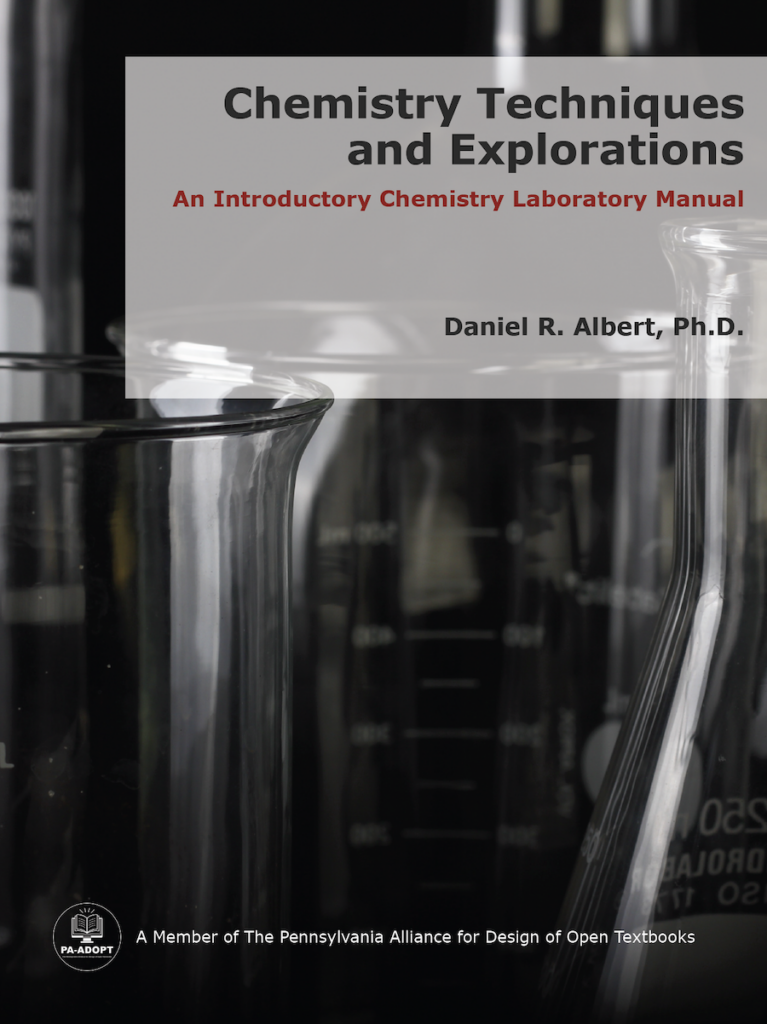Chemistry Techniques and Explorations: An Introductory Chemistry Laboratory Manual
by Daniel R. Albert, Ph.D.
Keywords: Lab Manual, Chemistry

About the Book
Chemistry Techniques and Explorations (2023) by Dr. Daniel R. Albert is an eTextbook laboratory manual for first semester introductory chemistry courses. The manual includes two different types of experiments (Technique and Exploration) designed to engage students in chemistry laboratory practices. Technique laboratories are designed for students to learn and practice chemistry laboratory skills that are utilized in a wide variety of disciplines. Exploration laboratories provide freedom and time for students to use previously acquired skills toward answering a new application focused question. Exploration laboratories help build the scientific thinking skills necessary to approach novel problems. The goal of this lab manual is to build both fundamental techniques and problem-solving skills that aid students in becoming practicing scientists.
Chapters
- Safety and Record Keeping
- Separating Substances, Measuring Mass, and Analyzing Data – Technique Laboratory
- Measuring Volumes – Technique Laboratory
- Reaction Types and Qualitative Analysis – Technique Laboratory
- What is Contaminating the Water Supply? – Exploration Laboratory
- Titrations Technique Laboratory
- What is the Acidity of Vinegar? – Exploration Laboratory
- Absorption Spectroscopy Technique Laboratory
- What is the Dye Composition of a Drink?-Exploration Laboratory
General Information
- Publication Year: 2023
- Edition: First
- Subject: Chemistry
- Latest File Update: November 18, 2025
License

This work is licensed under a Creative Commons Attribution-ShareAlike 4.0 International (CC BY-SA 4.0) as a part of PA-ADOPT, except where otherwise noted.
Usage
Readers
The eTextbooks created as a part of this program are provided in two formats: ePub and PDF. Please refer to our Reader Support section for guidance on which format may be best for you and the device(s) you use.
Instructors
If you are an instructor seeking to use this eTextbook in your own course(s) please feel free to download the ePub and/or PDF file(s) for your use, but make sure to complete our eTextbook Usage Survey (this information is used for program evaluation purposes).
If you are interested in making revisions and edits to this eTextbook please note that this is possible since the book is under a Creative Commons License, which allows you to remix, reuse, revise, and redistribute the eTextbook. Please refer to the Faculty Support Page, specifically looking at Remixing. You can download Chemistry Techniques and Explorations An Introductory Chemistry Laboratory Manual Apple Pages File in order to use the original document to revise and remix the eTextbook for your purposes.
Citations
MLA: Albert, Daniel. Chemistry Techniques and Explorations An Introductory Chemistry Laboratory Manual. First, The Pennsylvania Alliance for Design of Open Textbooks (PA-ADOPT), 2023.
APA: Albert, D. (2023). Chemistry Techniques and Explorations An Introductory Chemistry Laboratory Manual. (First). The Pennsylvania Alliance for Design of Open Textbooks (PA-ADOPT).
Chicago: Albert, Daniel. Chemistry Techniques and Explorations An Introductory Chemistry Laboratory Manual. First. The Pennsylvania Alliance for Design of Open Textbooks (PA-ADOPT), 2023.
Peer Review
This eTextbook went through an Open Peer Review process. The peer review process used the Open SUNY Textbook Peer Review Guidelines, allowing peer reviewers to read the text carefully and evaluate the following:
- Educational Significance of Content including accuracy, appropriate and useful materials, valid and significant concepts, models, and skills, and key elements;
- Effectiveness as a Teaching Resource including a clear explanation of the concepts, alignment of materials to the learning process of the target audience, and alignment of the learning objectives with course goals; and
- Readability and Ease of Use including clarity and comprehensiveness, consistent writing style, readability and ease of use (logic, sequence, and flow), appropriateness for target readership level, and quality of Interactivity and multimedia learning objects.
As a part of the open peer review process, the public review conducted by Dr. Ed Rajaseelan is made available: Peer Review Document (PDF).